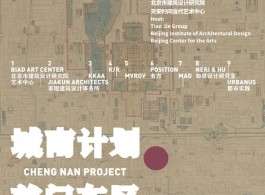Opening: 28th-10-2014
Duration: 29th-10-2014 to 28th-11
Location: No.1 Jade River, Ping An Ave., Dongcheng Dist., Beijing, China
Participates:
BIAD ART CENTER(Zhu Xiaodi)
JIAKUN ARCHITECTS(Liu Jiakun)
KKAA(Kengo Kuma)
K/R(John Keenen、Terence Riley)
MAD(Ma Yansong、Dang Qun、Yosuke Hayano)
MVRDV(Winy Maas、Jacob van Rijs、Nathalie de Vries)
POSITION(Shi Jian、Zhu Tao、Zhaolei)
SHEN WEI DANCE ARTS(Shen Wei)
URBANUS(Wang Hui、Liu Xiaodu、Meng Yan)
Artistic Director: Weng Ling
Host: Tian Jie Group, Beijing Institute of Architectural Design, Beijing Center for the Arts
The old town of Beijing composes of the inner and outer city, the outer city is known as Nan Cheng. Established during the Ming dynasty, this area was once known as “Zheng Dong” square, now Qianmen East Area or Xian Yu Kou. The area was the financial centre of the city in the Qing Dynasty, responsible for river logistics and counter flood measures. It includes “Chang Xiang” (1-5 lanes) and “Cao Chang” (1-10 lanes) hutongs, mostly running from north to south and uncharacteristically curved and winding compared to conventional hutongs. The structure of this area reflects how it came to be, developing around the river system and rich with history and culture.
Recently the revival of the Dashilar district received widespread attention and entered the Venice Biennale. However, the Xian Yu Kou area directly opposing the Dashilar is gradually degenerating, becoming irrelevant and decadent. The old and decaying streets and infrastructure creates a stark contrast to its rapidly developing neighbours.
The question of future development has been an ongoing question for years: how to revive an old area with minimal damage and preserve the architecture, the people residing within, and heritage? How to balance between economic development and environmental protection? We can look upon past projects such as Nan Luo Gu Xiang, 798 and Dashilar to point us in the right direction. As Dongcheng and Chongwen districts merge, the bigger Dongcheng district provides more land resources and financial strength, making the discussion of sustainable future development a relevant and important one.
With a dream of organic and sustainable urban development and city refurbishment, Beijing Tianjie Group, Beijing Institute of Architectural Design (BIAD) and Beijing Center for the Arts (BCA)unite forces and convene domestic and international specialists and experts in various fields to create an alliance panel from a wide range of professions. Led by renowned contemporary art curator and senior event organiser Ms. Weng Ling, seeking to explore new solutions to resolve issues of urban development in the age of rapid change and globalisation. Let Beijing’s past with the future, glory and anticipation all converge here.
Led by our panel of experts, this project aims to discuss contemporary issues from an academic perspective: a city’s change in space and functionality, refurbishment and inhabitant’s livelihood preservation, history and heritage site protection. The project will be conveyed through a large exhibition and discussion forums, using models, videos, interviews, installation projects and dance performances, bringing in culture, art, science, architecture and social considerations into one conversation. Believing in the contribution and different perspectives that each participant can make, this project embarks on a journey of exploration and realisation of a shared dream to contribute and improve our society and infrastructure, to revive past prosperity in a sustainable manner.




